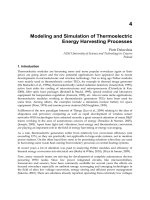Introduction to Electronics - Part 7 pdf
Bạn đang xem bản rút gọn của tài liệu. Xem và tải ngay bản đầy đủ của tài liệu tại đây (226.58 KB, 34 trang )
Introduction to Electronics
159
The Source Follower
R
sig
R
G
R
S
R
L
C
in
C
out
v
sig
v
o
+
+
-
-
V
DD
v
in
+
-
Fig. 228. Source follower circuit.
v
sig
R
sig
r
d
R
G
R
L
R
S
g
m
v
gs
v
o
+
+
-
-
G
S
D
v
in
+
-
i
in
v
gs
+
-
r
d
||
R
S
||
R
L
=
R
L
’
Fig. 229. Source follower small-signal equivalent circuit.
The Source Follower
Small-Signal Equivalent Circuit
This follower uses
fixed bias
:
I
G
= 0
V
GSQ
= 0
I
D
=
I
DSS
⇒⇒
Tremendously large R
in
is obtained by sacrificing bias stability,
which isn’t very important in this circuit anyway, as we shall see.
The small-signal equivalent is constructed in the usual manner:
Introduction to Electronics
160
The Source Follower
v
sig
R
sig
r
d
R
G
R
L
R
S
g
m
v
gs
v
o
+
+
-
-
G
S
D
v
in
+
-
i
in
v
gs
+
-
r
d
||
R
S
||
R
L
=
R
L
’
Fig. 230. Source follower small-signal equivalent circuit (Fig. 229
repeated).
vvv v vv
in gs o gs in o
=+ ⇒ =−
(233)
()
vgviR gv
v
R
Rvg
R
R
o m gs in L m gs
gs
G
Lgsm
G
L
=+
′
=+
′
=+
′
1
(234)
()
vvvg
R
R
oinom
G
L
=− +
′
1
(235)
1
11
++
′
=+
′
g
R
Rv vg
R
R
m
G
Lo inm
G
L
(236)
A
v
v
g
R
R
g
R
R
v
o
in
m
G
L
m
G
L
==
+
′
++
′
=
1
1
1
05. to 0.8 typically
(237)
Voltage Gain
This one requires a little more algebra. Beginning with:
and
We replace
v
gs
in eq. (234) with eq. (233), and solve for
v
o
/v
in
:
Introduction to Electronics
161
The Source Follower
v
sig
R
sig
r
d
R
G
R
L
R
S
g
m
v
gs
v
o
+
+
-
-
G
S
D
v
in
+
-
i
in
v
gs
+
-
r
d
||
R
S
||
R
L
=
R
L
’
Fig. 231. Source follower small-signal equivalent circuit (Fig. 229
repeated).
vvvvvg
R
R
in gs o gs gs m
G
L
=+=+ +
′
1
(238)
viRiRg
R
R
in in G in G m
G
L
=+ +
′
1
(239)
()
R
v
i
RgRR
in
in
in
GmGL
==++
′
1
(240)
Input Resistance
Replacing
v
o
in eq. (233) with eq. (234):
But
v
gs
=
i
in
R
G
:
Solving for
v
in
/
i
in
:
Because
I
G
= 0,
R
G
can be
several
M
Ω
. With the additional
multiplying factor of
R
L
’, R
in
can become
extremely large
!!!
Introduction to Electronics
162
The Source Follower
v
test
R
sig
r
d
R
G
R
S
g
m
v
gs
+
-
G
S
D
i
test
v
gs
+
-
Fig. 232. Determining output resistance of the source follower.
i
v
R
v
r
v
RR
gv
test
test
S
test
d
test
Gsig
mgs
=++
+
−
(241)
v
R
RR
v
gs
G
Gsig
test
=−
+
(242)
iv
RrRR
gR
RR
test test
Sd G sig
mG
Gsig
=++
+
+
+
11 1
(243)
Output Resistance
This calculation is a little more involved, so we shall be more formal
in our approach.
We remove
R
L
, apply a test source,
v
test
, and set the independent
source to zero.
From a KCL equation at the source node:
But
R
G
and
R
sig
form a voltage divider:
Substituting eq. (242) into eq. (241):
Introduction to Electronics
163
The Source Follower
v
test
R
sig
r
d
R
G
R
S
g
m
v
gs
+
-
G
S
D
i
test
v
gs
+
-
Fig. 233. Determining output resistance of the source follower (Fig.
232 repeated).
R
v
i
RrRR
gR
RR
o
test
test
Sd G sig
mG
Gsig
==
++
+
+
+
1
11 1
(244)
()
RRrRR
RR
gR
oSdGsig
Gsig
mG
=+
+
|| || ||
(245)
Thus:
Finally, we recognize this form as that of resistances in parallel:
Introduction to Electronics
164
Review of Bode Plots
Af
j
f
f
j
f
f
j
f
f
v
ZZ
P
()
=
+
+
12
1
1
1
(246)
Review of Bode Plots
Introduction
The emphasis here is
review
. Please refer to an appropriate text if
you need a more detailed treatment of this subject.
Let us begin with a generalized transfer function:
We presume the function is limited to certain features:
●
Numerator and denominator can be factored.
●
Numerator factors have only one of the two forms shown.
●
Denominator factors have only the form shown.
Remember:
●
Bode plots are
not the actual curves, but only asymptotes to
the actual curves
.
●
Bode magnitude plots are not based on the transfer function
itself, but on the logarithm of the transfer function - actually, on
20 log
A
v
.
●
The total Bode response for
A
v
(
f
) consists of the
magnitude
response
and the
phase response
. Both of these consist of
the sum of the responses to each numerator and denominator
factor.
Introduction to Electronics
165
Review of Bode Plots
0 dB
f
z1
20 dB/decade
Fig. 234. Bode magnitude
response for
jf
/
f
Z1
.
0 dB
f
z2
20 dB/decade
Fig. 235. Bode magnitude
response for 1 +
jf
/
f
Z2
.
The Bode Magnitude Response
Now, let’s review the Bode magnitude response of each term:
The numerator term :
j
f
f
Z
1
The magnitude response increases 20
dB per decade for all
f
.
For
f
=
f
Z1
the term has a magnitude of 1.
Thus the magnitude response has an
amplitude of 0 dB at
f
Z1
.
The numerator term :
1
2
+
j
f
f
Z
For
f
<<
f
Z2
the imaginary term is
negligible; the magnitude is just 0 dB.
For
f
>>
f
Z2
the imaginary term
dominates, thus the magnitude increases
20 db per decade.
The denominator term :
1
1
+
j
f
f
P
For
f
<<
f
P1
the imaginary term is
negligible; the magnitude is just 0 dB.
For
f
>>
f
P1
the imaginary term
dominates, thus the magnitude
decreases 20 db per decade (because
the term is in the denominator).
0 dB
f
p
-20 dB/decade
Fig. 236. Bode magnitude
response for 1 +
jf
/
f
P1
.
Introduction to Electronics
166
Review of Bode Plots
+90
O
Fig. 237. Bode phase response
for
jf
/
f
Z1
.
0
O
f
z2
/10
10
f
z2
+90
O
45
O
/decade
Fig. 238. Bode phase response
for 1 +
jf
/
f
Z2
.
The Bode Phase Response
Now, let’s review the Bode phases response of each term:
The numerator term :
j
f
f
Z
1
The phase response is simply 90
o
for all
f
.
The numerator term :
1
2
+
j
f
f
Z
For
f
<<
f
Z2
the imaginary term is
negligible; the phase is just 0
o
.
For
f
>>
f
Z2
the imaginary term
dominates, thus the phase is 90
o
.
At
f
=
f
Z2
, the term is 1 +
j
1; its phase is
45
O
.
The denominator term :
1
1
+
j
f
f
P
For
f
<<
f
Z2
the imaginary term is
negligible; the phase is just 0
o
.
For
f
>>
f
Z2
the imaginary term
dominates, thus the phase is -90
o
.
At
f
=
f
Z2
, the term is 1 +
j
1; its phase is
-45
O
.
0
O
f
p
/10
10
f
p
-45
O
/decade
-90
O
Fig. 239. Bode phase response
for 1 +
jf
/
f
P1
.
Introduction to Electronics
167
Review of Bode Plots
V
o
(s)
R
+
1/
sC
V
in
(s)
+
-
Fig. 240. Single-pole low-pass
RC
circuit,
A
V
V
sC
R
sC
sRC
v
o
in
==
+
=
+
1
1
1
1
(247)
()
A
jRCf
j
f
f
f
RC
v
b
b
=
+
=
+
=
1
12
1
1
1
2
ππ
where
(248)
A
f
f
v
b
=
+
1
1
2
2
(249)
Single-Pole Low-Pass RC
The review of the details of the
Bode response of a single-pole
low-pass
RC
circuit begins with
the s-domain transfer function:
Note that there is a pole at
s
= -1/
RC
and zero at
s
= .
∞
For the sinusoidal steady state response we substitute
j
2
π
f
for
s
:
This fits the generalized single-pole form from the previous page,
except we’re using “
f
b
” instead of “
f
P
.” The term
f
b
is called the
half-
power
frequency, the
corner
frequency, the
break
frequency, or the
3-dB
frequency.
Gain Magnitude in dB:
From:
Introduction to Electronics
168
Review of Bode Plots
()
A
f
f
f
f
f
f
f
f
v
dB
b
b
bb
=
+
=− +
=− +
=− +
20
1
1
20 1 20 1
20 1 10 1
2
2
2
2
2
22
log log log
log log
(250)
()
A
v
dB
=− =
10 1 0log dB
(251)
A
f
f
f
f
v
dB
bb
=−
=−
10 20
2
log log
(252)
f
b
/10
f
b
10
f
b
100
f
b
-3 dB
-40 dB
-20 dB
A
v
, dB
f
Fig. 241. Bode magnitude plot for single-pole low-
pass, in red. The actual curve is shown in blue.
We obtain:
Bode Magnitude Plot:
From eq. (250), at
low
frequencies (
f
/
f
b
<< 1):
And, at
high
frequencies (
f
/
f
b
>> 1):
Note that the latter
equation decreases 20
dB for each factor of 10
increase in frequency
(i.e., -20 db per
decade
).
Introduction to Electronics
169
Review of Bode Plots
f
/
f
b
1
θ
θθ
θ
Re
Im
Fig. 242. Trigonometric representation
of transfer function phase angle.
A
j
f
f
v
b
=
+
1
1
(253)
θ
A
b
v
f
f
=−
arctan
(254)
f
b
/10
f
b
10
f
b
100
f
b
θ
, deg
f
0
O
-45
O
-90
O
Fig. 243. Bode phase plot for single-pole low-pass,
shown in red. The actual curve is shown in blue.
Bode Phase Plot:
From the transfer function:
The transfer function phase angle
is:
The Bode phase plot shows the characteristic shape of this inverse
tangent function:
Introduction to Electronics
170
Review of Bode Plots
V
o
(s)
R
+
1/
sC
V
in
(s)
+
-
Fig. 244. Single-pole high-pass RC
circuit.
A
R
sC
R
sRC
sRC
v
=
+
=
+
1
1
(255)
()
()
A
jRCf
jRCf
j
f
f
j
f
f
f
RC
v
b
b
b
=
+
=
+
=
2
12
1
1
2
π
ππ
where
(256)
A
f
f
f
f
v
dB
bb
=
−+
20 20 1
2
log log
(257)
Single-Pole High-Pass RC
The s-domain transfer function:
Note there is a pole at
s
= -1/
RC
,
and a zero at
s
= 0.
For the sinusoidal steady state response we substitute
j
2
π
f
for
s
:
Bode Magnitude Plot:
Because this is a review, we go directly to the resulting gain
equation:
Recall from Fig. (234) that the first term is a straight line, with +20
dB/dec slope, passing through 0 dB at
f
b
.
The last term is
the same term
from the low pass example, which
has the form of Fig. (236).
The total Bode magnitude response is merely the sum of these two
responses.
Introduction to Electronics
171
Review of Bode Plots
f
b
/10
f
b
10
f
b
100
f
b
-3 dB
-40 dB
-20 dB
A
v
, dB
f
Fig. 245. Bode magnitude plot for single-pole high
pass, in red. The actual curve is shown in blue.
f
b
/10
f
b
10
f
b
100
f
b
θ
, deg
f
90
O
45
O
0
O
Fig. 246. Bode phase plot for single-pole high-pass,
in red. The actual curve is shown in blue.
θ
A
b
v
f
f
=°−
90 arctan
(258)
Adding the two individual responses gives:
Bode Phase Plot:
The transfer function leads to the following phase equation:
This is just the low-pass phase plot shifted upward by 90
o
:
Introduction to Electronics
172
Coupling Capacitors
R
S
R
B
R
C
R
L
C
in
C
out
v
s
v
o
+
+
-
-
V
CC
Q
1
v
in
+
-
Source
Amplifier
Load
Fig. 247. Representative amplifier circuit, split into sections.
R
B
r R
C
β
i
b
i
b
Fig. 248. Amplifier sm. sig. eq. ckt.
R
in
R
o
+
-
+
-
v
x
A
vo
v
x
Fig. 249. Model equivalent to
amplifier section.
Coupling Capacitors
Effect on Frequency Response
In our
midband amplifier analysis
, we assumed the capacitors were
short circuits, drew the small-signal equivalent, and analyzed it for
overall gain (or other parameters). This time, though:
(1) we can draw the sm. sig. eq.
ckt. of the amplifier section
only
,
(2) analyze it, determine the its
model parameters, and . . .
Introduction to Electronics
173
Coupling Capacitors
R
in
R
o
+
-
+
-
v
x
A
vo
v
x
R
L
C
out
v
o
+
-
R
S
C
in
v
s
+
-
Fig. 250. Complete circuit redrawn with amplifier section replaced by its model.
()
f
CR R
in S in
1
1
2
=
+
π
(259)
()
f
CR R
out o L
2
1
2
=
+
π
(260)
. . . (3) redraw the
entire
circuit (Fig. 247) as shown:
Note that both sides are identical topologically, and are
single-pole,
high-pass circuits
:
On the left: On the right:
At frequencies above
f
1
and
f
2
, the Bode magnitude plots from
these high-pass circuits are simply horizontal lines at 0 dB, which
add to become a single horizontal line at 0 dB. Of course, the
amplifier (and resistive dividers) will shift this horizontal line
(hopefully upward, because we probably want
A
v
> 1). .
Suppose we begin somewhere
above
f
1
and
f
2
-
at midband
. . . we
already know how to find the midband gain, which will become
on the Bode magnitude plot.
20log
A
v
mid
Now let’s work our way
lower
in frequency. . . when we get to the
first of the two pole frequencies, our Bode magnitude plot begins to
drop at 20 dB/decade. . . when we get to the second pole, the plot
drops at 40 dB/decade. . . see the illustration on the next page.
Introduction to Electronics
174
Coupling Capacitors
20 log
A
v mid
f
1
f
2
20 dB/dec
40 dB/dec
Fig. 251. Generalized Bode magnitude plot of an amplifier with
coupling capacitors. Here
f
1
is assumed to be lower than
f
2
.
Note that the presence of
f
1
moves the overall half-power frequency
above
f
2
.
Constructing the Bode Magnitude Plot for an Amplifier
1.
Analyze the circuit with the coupling capacitors replaced by
short circuits to find the midband gain.
2.
Find the break frequency due to each coupling capacitor.
3.
Sketch the Bode magnitude plot by beginning in the midband
range and moving toward lower frequencies.
Introduction to Electronics
175
Design Considerations for
RC
-Coupled Amplifiers
Design Considerations for
RC
-Coupled Amplifiers
1.
RC
-Coupled amplifiers:
Coupling capacitors - capacitors cost $
Direct-Coupled amplifiers:
No capacitors - bias circuits interact - more difficult design, but
preferable.
2.
Determine Thevenin resistance “seen” by each coupling
capacitor.
Larger resistances mean smaller and cheaper capacitors.
3.
Choose
f
b
for each
RC
circuit to meet overall -3 dB
requirement.
Judicious choice can reduce overall cost of capacitors.
4.
Calculate required capacitance values.
5.
Choose C values somewhat larger than calculated
(approximately 1.5 times larger).
Some C tolerances are as much as -20%, +80 %. Vales can
change with time and temperature.
±
10 %
Introduction to Electronics
176
Low- & Mid-Frequency Performance of CE Amplifiers
R
S
R
1
R
2
R
C
R
EB
R
L
C
in
C
out
v
s
v
o
+
+
-
-
V
CC
Q
1
v
in
+
-
C
E
R
EF
Fig. 252. Generic single-supply common emitter ckt.
(Let
R
B
=
R
1
||
R
2
,
R
L
’
=
R
L
||
R
C
,
R
E
=
R
EF
+
R
EB
)
R
S
R
B
R
C
R
EB
R
L
C
in
C
out
v
s
v
o
+
+
-
-
V
CC
Q
1
v
in
+
-
C
E
R
EF
-V
EE
Fig. 253. Generic dual-supply common emitter ckt.
(Let
R
L
’
=
R
L
||
R
C
,
R
E
=
R
EF
+
R
EB
)
Low- & Mid-Frequency Performance of CE Amplifier
Introduction
We begin with two of the most common topologies of common-
emitter amplifier:
Introduction to Electronics
177
Low- & Mid-Frequency Performance of CE Amplifiers
v
s
R
S
R
B
r
R
L
’
β
i
b
v
o
+
+
-
-
B
E
C
i
b
v
in
+
-
i
in
i
o
R
EF
R
C
R
L
R
in
Fig. 254. Generic small-signal equivalent of common emitter amplifier.
()
A
v
v
R
rR
R
R
v
o
in
L
EF
L
EF
==
−
′
++
≈
−
′
>>
β
β
β
π
1
1,if
(261)
A
v
v
A
R
RR
v
o
s
v
in
Sin
s
==
+
(262)
()
[]
R
v
i
Rr R
in
in
in
BEF
== ++
||
π
β
1
(263)
A
i
i
A
R
R
R
RR
R
RR
i
o
in
v
R
v
R
v
in
L
C
CL
B
BX
o
L
in
in
== = =−
++
β
(264)
Both
common-emitter topologies have the same small-signal
equivalent circuit:
Midband Performance
For the equivalent circuit shown,
R
o
=
R
C
, but if we include the BJT
output resistance
r
o
in the equivalent circuit, the calculation of
R
o
becomes much more involved. We’ll leave this topic with the
assumption that
R
o
R
C
.
≈
The focus has been
A
v
, but we can determine
A
i
also:
where
R
X
=
r
π
+ (
β
+ 1)
R
EF
.
Introduction to Electronics
178
Low- & Mid-Frequency Performance of CE Amplifiers
Design Considerations
●
In choosing a device we should consider:
Frequency performance
Noise figure
Power Dissipation
Device choice may not be critical. . .
●
Design Tradeoffs:
1.
R
B
large for high
R
in
and high
A
i
R
B
small for bias (
Q
-pt.) stability
2.
R
C
large for high
A
v
and
A
i
R
C
small for low
R
o
, low signal swing, high frequency
response
3.
R
EF
small (or zero) for maximum
A
v
and
A
i
R
EF
> 0 for larger
R
in
,
gain stability
, improved high and
low frequency response, reduced distortion
●
Gain Stability:
Note from eq. (261), as
R
EF
increases,
A
v
-
R
L
’/
R
EF
, i.e., gain
≈
becomes independent of
β
!!!
Introduction to Electronics
179
Low- & Mid-Frequency Performance of CE Amplifiers
v
s
R
S
R
B
r
π
R
L
β
i
b
v
o
+
+
-
-
B
E
C
i
b
v
in
+
-
i
in
i
o
R
EF
C
out
C
in
R
C
Fig. 255.Approximate sm. sig. equivalent of the CE amplifier at low
frequencies. The effect of
C
E
is ignored by replacing it with a short circuit.
C
in
and
C
out
remain so that their effect can be determined.
f
RC
b
Thevenin
=
1
2
π
(265)
()
f
RRC
out
C L out
=
+
1
2
π
(266)
for
A
v
v
f
RC
v
o
in
in
in in
==
1
2
π
(267)
()
for
A
v
v
f
RRC
v
o
s
in
Sinin
==
+
1
2
π
(268)
The Effect of the Coupling Capacitors
To determine the effect of the coupling capacitors, we approximate
the small-signal equivalent as shown.
C
in
and
C
out
are then a part
of independent single-pole high-pass circuits, with break
frequencies of:
Thus the effect of
C
out
is:
And the effect of
C
in
is:
Equations for
f
in
are approximate, because the effects of
C
in
and
C
E
interact slightly. The interaction is almost always negligible.
Introduction to Electronics
180
Low- & Mid-Frequency Performance of CE Amplifiers
v
s
R
S
R
B
r
π
R
L
’
β
i
b
v
o
+
+
-
-
B
E
C
i
b
v
in
+
-
i
o
R
EF
C
E
R
EB
Fig. 256. Approximate common emitter sm. sig. equivalent at low frequencies.
Only the effect of
C
E
is accounted for in this circuit.
A
v
, dB
f
1
C
E
= short ckt.
C
E
= open ckt.
f
f
2
Fig. 257. Bode magnitude plot showing the effect
of
C
E
only.
The Effect of the Emitter Bypass Capacitor C
E
Consider the following:
At sufficiently high frequencies,
C
E
appears as a short circuit. Thus
the total emitter resistance is at its lowest, and
A
v
is at its highest.
This appears like, and is, the standard single-pole high-pass effect.
At sufficiently low frequencies
C
E
appears as an open circuit. The
total emitter resistance is at its highest, and
A
v
is at its lowest,
but
A
v
is not zero!!!
Thus, there is not just a single-pole high-pass
effect.
There must also be a zero at a frequency other than f = 0
,
as shown below:
Introduction to Electronics
181
Low- & Mid-Frequency Performance of CE Amplifiers
R
B
r
π
R
L
’
β
i
b
v
o
+
-
B
E
C
i
b
v
in
+
-
i
in
i
o
R
EF
R
EB
R
thevenin
R
X
R
Y
Fig. 258. Finding Thevenin R “seen” by
C
E
, assuming we are interested
in
v
o
/
v
in
, i.e., assuming
R
S
= 0.
i
c
i
test
i
b
r
β
i
b
v
be
+
-
v
test
+
Fig. 259. Finding
R
Y
.
()
RRRRRR
Thevenin EB X EB EF Y
== +
|| ||
(269)
i
v
r
v
r
b
be test
==−
ππ
(270)
()
ii
test b
=− +
β
1
(271)
R
v
i
r
Y
test
test
==
+
π
β
1
(272)
()
R
RR r
Y
BS
=
+
+
||
π
β
1
(273)
To find the pole frequency
f
1
we need the Thevenin resistance
“seen” by
C
E
:
From inspection we should see that:
The difficulty is finding
R
Y
, which is undertaken below:
If
R
S
0, then
R
Y
becomes:
≠
Introduction to Electronics
182
Low- & Mid-Frequency Performance of CE Amplifiers
f
CR R
r
EEB EF
1
1
2
1
=
+
+
π
β
π
||
(274)
20 log
A
v mid
f
out
20 dB/dec
f
2
f
1
f
in
40 dB/dec
40 dB/dec
60 dB/dec
Fig. 260. One example of the
Bode plot of a CE amplifier.
f
CR R
rRR
EEB EF
BS
1
1
2
1
=
+
+
+
π
β
π
||
(||
(275)
f
CR
EEB
2
1
2
=
π
(276)
Thus, for
A
v
=
v
o
/
v
in
:
Or, for
A
v
=
v
o
/
v
s
:
The zero
f
2
is the frequency where :
Zjf R
jf C
EE
E
() ||
2
2
1
==∞
The mathematical derivation of eq. (276) is not a focus of this
course; it is left for your own endeavor.
The Bode magnitude plot of a common
emitter amplifier is the summation of the
effects of poles
f
in
,
f
out
,
f
1
, and the zero
f
2
.
One of many possible examples is shown
at left.
Introduction to Electronics
183
The Miller Effect
Z
V
in
V
out
= A
v
V
in
+
+
-
-
I
z
“Black Box”
Fig. 261. Circuit with feedback impedance
Z
. The
black box is usually an amplifier, but can be any
network
with a common node
.
V
in
V
out
= A
v
V
in
+
+
-
-
I
z
“Black Box”
Z
in, Miller
Z
out, Miller
Fig. 262. Circuit to be made equivalent to the previous
figure.
The Miller Effect
Introduction
Before we can examine the high frequency response of amplifiers,
we need some additional tools. The Miller Effect is one of them.
Consider:
It is difficult to analyze a circuit with a feedback impedance, so we
wish to find a circuit that is equivalent at the input & output ports:
If we can choose
Z
in. Miller
so that
I
z
is the same in both circuits, the
input port won’t “know” the difference - the circuits will be equivalent
at the input port.









